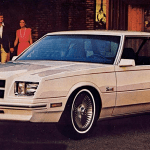
Due for a complete overhaul for 1980, Chrysler’s personal-luxury coupe would form the basis for an odd and arguably ill-conceived tribute car, and lose its identity in the process. Steeped in history, the 300 package added $2040 to price of the 1979 Cordoba, and when so equipped, transformed the car to the Chrysler 300—no Cordoba. And, significantly–no letter.
What was the 1979 Chrysler 300?
Overview
For those unaware, the Chrysler 300-series cars were performance-oriented large coupes, generally based on the brand’s New Yorker. These included the “letter-series cars,” with designations which ascended through the alphabet as the model years passed by, and the non-letter cars, which came later.
The 300s always featured the highest-performance engine available from Chrysler at the moment, as well as unique trim, and occasionally enhanced suspension tuning. The first letter car, the C-300, debuted for 1955. The last—not counting the Cordoba, was the 1971 300. And, almost without exception, the 300s represented the Chrysler brand at its best.

Though perhaps not as ingrained in car culture as something like the Ford Mustang, the 300 cars were—and are—much appreciated by Chrysler fans and loyalists. And, as Chrysler—the parent company—enteried a dark period of eroding sales and profits, a callback to happier times seemed to make sense. But, could such a car–in an era of emissions controls strangling vehicle performance–due justice to the cars it was built to honor?
Enter the 1979 Chrysler 300.
Offered only in Spinnaker White, the 300 enjoyed a number of exterior trim and cabin updates.

300 Package
On the outside, the 300 enjoyed unique alloy wheels (shod with raised-while-letter tires) not offered on other Cordobas. A unique grille fitted with a “300” medallion replaced the regular Cordoba grille and hood ornament. The not-a-Cordoba was also treated to a unique taillight design and, this is pretty cool, rear side glass etched with the number 300. The bumper inserts were also “colored keyed,” or white, in this case, giving the 300 a likable monochromatic look. Pinstripes and “sport” mirrors completed the look.
As for the cabin, 300s came only with bucket seats and a console-mounted shifter, and were fitted with unique door panels and a sporty gauge cluster which included a tachometer. Red leather was the only upholstery offering.
Engines
Things get interesting under the hood. While the 400-cubic-inch V8 once offered in the Cordoba was gone, the company did come up with a premium powerplant for the 300. While other 1979 Cordobas made do with either a mildly tuned 318- or 360-inch V8, the 300 was fitted with a tweaked version of the 360.
Fitted a unique camshaft, 4-barrel carburetor, and dual-exhaust system, the 300’s engine cranked out 195 horsepower, a sold number for 1979, and fully 50 more than the standard 360. To further improve acceleration, the 300 was fitted with a 3.21 rear axle, this in place of the standard 2.71 unit.
The 300 also enjoyed heavy-duty front torsion-bars, and beefed-up rear leaf springs. Heavy-duty shock absorbers and recalibrated steering were also part of the package.
Performance
One period review put the 300’s 0-60 mph time at just under 10 seconds, which, all things considered, is actually pretty impressive. Another review put the Cordoba’s 0-60 performance at 13.5 seconds when equipped with the standard 318-inch engine. So, the 300 step up in power was meaningful.
Sales
In all, 3811 300s (Cordobas with the 300 package) were sold in 1979, the only year it was offered. A similar packaged was offered on the redesigned and downsized 1980 Cordoba, but was named Cordoba LS instead of 300. We’ll have to look into how popular that package was, though this author has never seen one on the street.
Value
It’s easy to look back now and scoff at the 1979 300, but for its day it offered a level of style and performance that was a meaningful improvement over mainstream period offerings. A quick look reveals asking prices ranging from just $6000, to $30,000 for an example in excellent condition.
And, as for the rumor that a few red examples were produced for the Canadian market…well, who knows? Message boards say yes, Chrysler sales material says no. If you know, let us know.
Smaller Still: The Personal Luxury Cars of 1980

Listen to the Car Stuff Podcast
1979 Chrysler 300 Pictures
Click below for enlarged images










The coolest Cordoba.